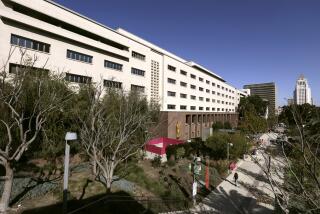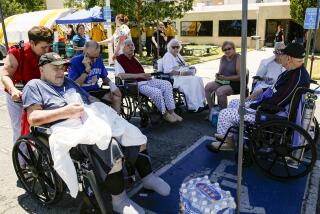Barlow Hospital’s Bidding Battle
- Share via
Barlow Respiratory Hospital has a storied past. One of Los Angeles’ oldest hospitals, with a charitable legacy of serving low-income patients, the 103-year-old facility on the western edge of Dodger Stadium also is designated by the city as a historic landmark.
But the nonprofit hospital’s future is uncertain. Its board of directors has decided to sell its pastoral campus to survive. The possible sale sets the stage for battles among developers wanting to build condominiums, preservationists hoping to save the landmark structures, activists desiring more low-income housing and park advocates seeking more open space.
The winners and losers could very well be determined by the Los Angeles City Council in a key test of its ability to choose among conflicting urban development strategies.
Barlow’s plight also serves as an example of the burdens faced by many healthcare providers across California as they struggle to meet strict new earthquake safety standards.
Barlow can’t make its main infirmary, built in 1927, comply with the tougher earthquake safety laws going into effect for many California hospitals in 2013, Chief Executive Margaret Crane said. Structural upgrades would be too costly for a building that is already obsolete by modern medical standards.
“The rooms are tiny, the nursing stations are tiny and there is no room for equipment,” Crane said. “It’s not something we would want to retrofit.”
Barlow administrators are collecting bids for the 25-acre site, hoping to raise enough money to build a new facility on a sliver of their rambling Stadium Way location or elsewhere in the region. A new hospital would cost as much as $60 million.
The property has about 40 buildings dating as far back as 1903, some of them crumbling and unused. The buildings were mostly built through the first half of the 20th century to provide a haven for tuberculosis patients who couldn’t afford the lengthy treatments common at the time. The structures are several different styles of architecture, including Craftsman wood frame and Spanish Revival masonry construction.
Barlow’s decision to sell sets up a humdinger of a land-use conflict. Most interest in the property is from residential developers, who typically want to build as many units as possible to maximize their profits.
The city has a widely acknowledged housing shortage, but planners also agree there is a dearth of open space and parks. Los Angeles has been frequently criticized for letting many of its historic buildings be demolished, and preservationists are not going to stand idly by if another landmark is threatened.
Then there are the still-smarting wounds of Latino families that remember being forced out of the neighborhood in the 1950s to make way for the construction of public housing, only to see the city cut a deal with the Dodgers for a baseball stadium instead. Developers who seek to profit in Chavez Ravine may face their smoldering ire.
On top of all that, the property is zoned for agricultural use, and a new development would require persuading the city to rezone the land for denser occupancy.
“The highest and best use now would probably be growing strawberries,” real estate appraiser David Zoraster of CB Richard Ellis said jokingly. “You can’t just automatically change the zoning.”
If the land was empty and zoned for high-density market-rate apartments or condos, it could be worth more than $100 million, Zoraster said. But uncertainty about rezoning and historical preservation issues would push its value far lower.
Crane did not reveal the price range of offers but said hospital officials would close the bidding in about two weeks. Buyers would have to take the property as is, she said.
“If we don’t make some plans now and find a place to go, we’ll be out of business in 2013 -- and then we’d still have to sell the property,” Crane said.
Rezoning “is possible,” said City Councilman Ed Reyes, whose district includes the site. He hopes to play peacemaker in what looks like an impending land-use clash. The solution may hang on an architect’s ability to design a complex that incorporates the best of Barlow’s historic structures and includes a large portion of low-income housing, yet is still profitable for the developer, Reyes said.
Preserving the historic structures is essential for Ken Bernstein of the Los Angeles Conservancy. Barlow has “one of the most impressive and eclectic collections of early 20th century architecture in the city,” he said.
A 1992 analysis of the property identified 31 structures that could contribute to a potential national landmark designation, Bernstein said. “We would hope that a developer would view this unquestioned historic site as an asset, not an obstacle.”
The hospital was founded by W. Jarvis Barlow, a New York physician who contracted a mild case of tuberculosis and came to Los Angeles in the 1890s to recuperate. The most popular treatment for the lung disease at the time called for extended periods of rest in warm, dry climates, and Southern California was a magnet for respiratory patients.
Barlow and his wife, Marion, set out to build a sanatorium where the less fortunate could recover. They selected 25 acres of meadowland amid rolling hills next to city-owned Elysian Park and paid J.B. Lankershim $7,300 for the land.
The Barlows persuaded the prominent farmer and developer to give back $1,000 as a donation and received $1,300 from civil engineer Alfred Solano, kicking off a perpetual fundraising drive that tapped the city’s elite. In the years ahead, the Torrances, Slausons, Newhalls and other prominent families would contribute to the sanatorium.
Their dollars paid for new buildings, including a recreation hall, library and several cottages for patients. By the time Barlow died in 1937, there were 99 beds in the hospital. With tuberculosis mostly tamed after effective medicines were developed in the 1940s and 1950s, the hospital now specializes in weaning patients off ventilators and has a license for 49 beds.
Jarvis Barlow also set up a board of directors, which still runs hospital affairs and must decide with other hospital leaders which buyer’s offer to pursue. The Dodgers are not involved in the bidding, according to hospital and team representatives.
Barlow has been a good neighbor, said M. Scott Fajack, a nearby homeowner who heads the Citizens Committee to Save Elysian Park. Yet he is wary of new construction in the area.
“We would most likely come out against housing developments and would really fight changes in zoning or the cultural landmark status of the site,” he said.
Also poised for battle is Neighbors of Dodger Stadium leader Virginia Pinedo, a lifetime resident of Chavez Ravine who is still angry about the baseball power play more than half a century later.
“What I would push for is asking how much of that housing would be offered to the families of the people that were scattered to the four winds” by the stadium’s construction, she said.
Councilman Reyes acknowledges “the emotional factor is very high” when it comes to the future of Barlow. Finding a solution the parties can live with, he predicted, “will require a lot of pain and a lot of engagement.”
More to Read
Sign up for Essential California
The most important California stories and recommendations in your inbox every morning.
You may occasionally receive promotional content from the Los Angeles Times.











